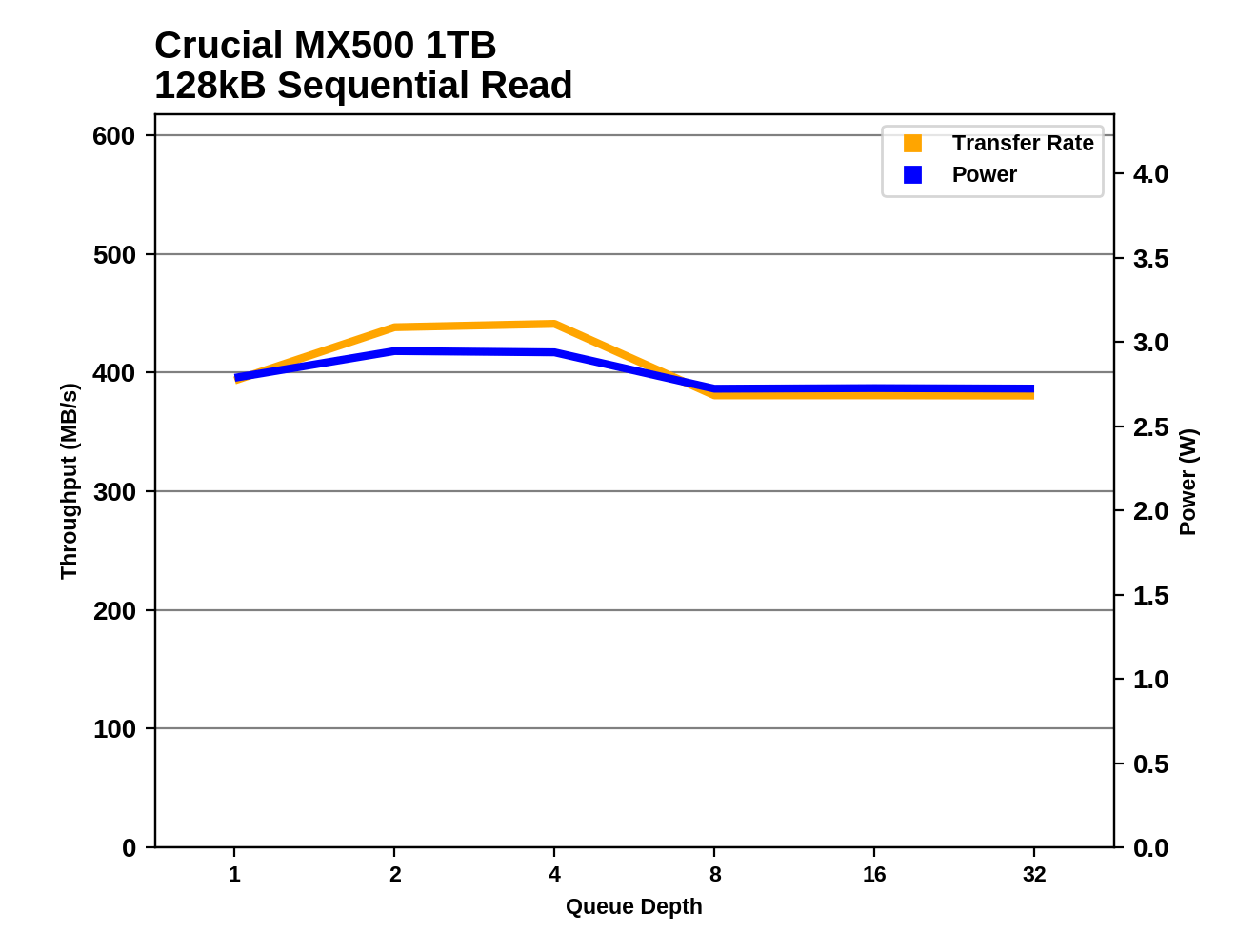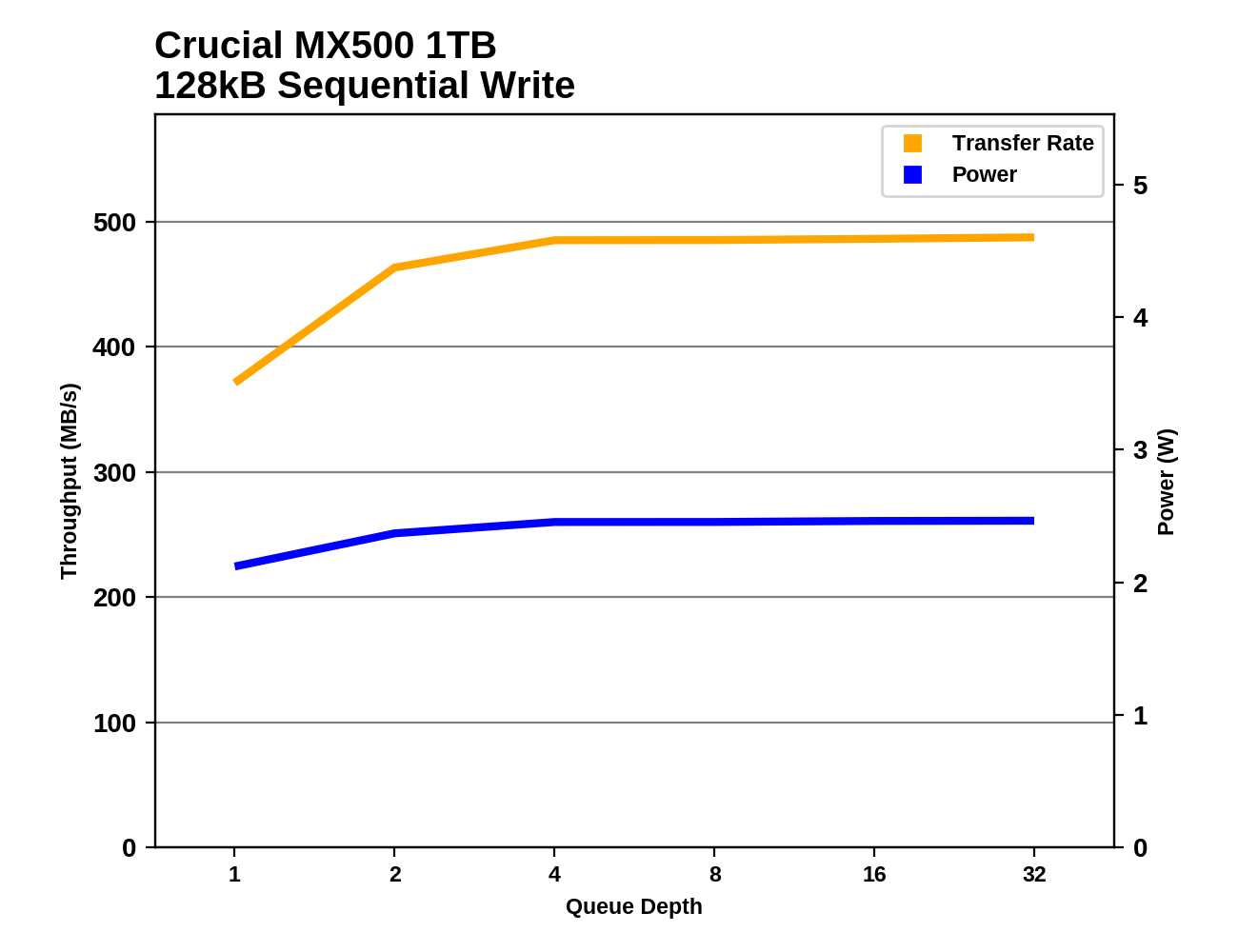The Crucial MX500 1TB SSD Review: Breaking The SATA Mold
by Billy Tallis on December 19, 2017 8:00 AM ESTSequential Read Performance
Our first test of sequential read performance uses short bursts of 128MB, issued as 128kB operations with no queuing. The test averages performance across eight bursts for a total of 1GB of data transferred from a drive containing 16GB of data. Between each burst the drive is given enough idle time to keep the overall duty cycle at 20%.

The Crucial MX500 turns in another record-setting burst performance score with its sequential read results, but by the smallest margin yet. It's about 6% faster on this test than most mainstream SATA SSDs.
Our test of sustained sequential reads uses queue depths from 1 to 32, with the performance and power scores computed as the average of QD1, QD2 and QD4. Each queue depth is tested for up to one minute or 32GB transferred, from a drive containing 64GB of data.

The sustained sequential read performance of the Crucial MX500 puts it in second place, behind the Samsung 850 PRO and 850 EVO. The MX500 does have a slight advantage over the other 64L 3D TLC drives, and improves on the MX300's performance by an impressive 100 MB/s.

The power efficiency of the Crucial MX500 during sequential reads is mediocre and clearly worse than the other 64L 3D TLC drives, including the Intel 545s. The MX500 is slightly more efficient than the Samsung 850 PRO and EVO, and scores 21% higher than the MX300.
 |
|||||||||
The Samsung 850 PRO and EVO are the only drives that continuously saturate the SATA bus from QD2 onwards with no drops in performance. The MX500's performance is reasonably steady but does drop a bit as the test wears on.
Sequential Write Performance
Our test of sequential write burst performance is structured identically to the sequential read burst performance test save for the direction of the data transfer. Each burst writes 128MB as 128kB operations issued at QD1, for a total of 1GB of data written to a drive containing 16GB of data.

For once, the burst performance of the Crucial MX500 doesn't set a record. Its QD1 sequential write speed is only second-fastest, about 3% slower than the Samsung 850 PRO.
Our test of sustained sequential writes is structured identically to our sustained sequential read test, save for the direction of the data transfers. Queue depths range from 1 to 32 and each queue depth is tested for up to one minute or 32GB, followed by up to one minute of idle time for the drive to cool off and perform garbage collection. The test is confined to a 64GB span of the drive.

The sustained sequential write speed of the MX500 is the same as the MX300, putting them in the second tier of performance behind the Samsung 850 PRO and EVO and the MLC-based Patriot Ignite.

The Crucial MX500 scores great on power efficiency during sequential writes, but not quite as well as the MX300. The OCZ VX500 with its reduced DRAM cache holds on to first place and the Toshiba TR200 (entirely DRAMless) comes in right behind the MX500. The mainstream 3D TLC drives are all much less efficient.
 |
|||||||||
Only a few drives offer a higher sustained sequential write speed than the MX500 after reaching saturation. The Samsung drives and the Patriot Ignite are faster at all queue depths and much less pwoer efficient than the MX500, while the OCZ VX500 stumbles at QD2 before saturating with slightly higher throughput and substantially lower power consumption. The MX300 is a bit faster than the MX500 at QD2 but slightly slower at higher queue depths.










90 Comments
View All Comments
Kristian Vättö - Wednesday, December 20, 2017 - link
MLC and TLC are different at die level. Once the wafer is produced it's no longer possible to switch from MLC to TLC or vice versa. Sure TLC could be used in pseudo-MLC mode by only programming the lower and middle pages, but that is not the same thing.mode_13h - Wednesday, December 20, 2017 - link
I'm not saying you're wrong, but please explain how Crucial's Dynamic Write Acceleration gets a significant write performance benefit by doing similar.MajGenRelativity - Tuesday, December 19, 2017 - link
I'm pleased with this product. Keep up the good work Micron, and keep lowering SSD prices!jjj - Tuesday, December 19, 2017 - link
A bit suspicious that there are no specs and prices for the 512GB version, hopefully the perf drop won't be too large.Other than that, all good here.
Billy Tallis - Tuesday, December 19, 2017 - link
Officially, Crucial is only launching the 1TB model today. The other capacities have to wait a little longer for a proper announcement.The Benjamins - Tuesday, December 19, 2017 - link
They will offically have a 250GB, 500GB, 1TB, 2TB models in 2.5" and up to 1TB in M.2http://www.crucial.com/wcsstore/CrucialSAS/pdf/pro...
witp - Tuesday, December 19, 2017 - link
Got other capacities prices, unofficialy ofc.Excl VAT, incl distributors' margin, for both M.2 and 2.5'' versions, that will be:
250GB ~74USD
500GB ~130USD
1TB ~238USD ; for comparison
2TB 2.5'' only ~465USD
Availability here in duckland ;) please don't mistake with Deutchland ;))) for W02/18
jjj - Tuesday, December 19, 2017 - link
I supposes my comment wasn't clear enough, wasn't suggesting it's your fault. Anyway, these things are always on purpose and it seems that they don't want to talk about lower capacities at all, they want people to see the MX500 perf as it is today at 1TB. A bit of a red flag but hopefully 512GB will be ok too.Billy Tallis - Tuesday, December 19, 2017 - link
I'm expecting them to sample at least one of the smaller capacities, if not all of them. I did mention recently that I probably would have given the BX300 an award if they had sent me the 120GB model, because that one is such a clear winner above the sparse competition in that capacity range.jjj - Tuesday, December 19, 2017 - link
They've been doing a pretty good job with both MX and BX series, good deals usually.With the new CEO they should start pushing harder in SSD. I think they had some issues a few months back and maybe that's why this one got delayed but I would expect to see them focusing more on SSD.